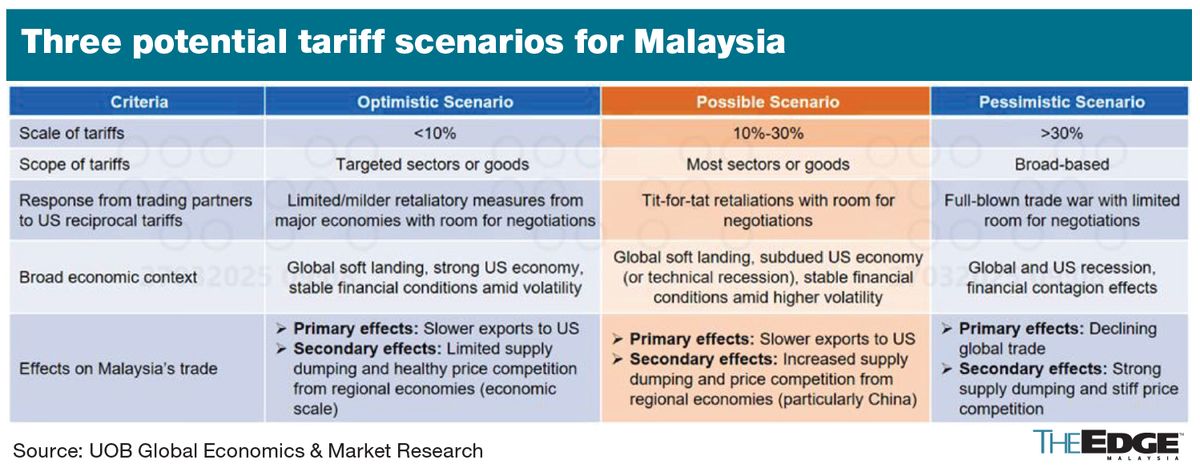
KUALA LUMPUR (March 27): Malaysia’s electrical and electronics (E&E), rubber, furniture and optical and scientific equipment exports are the most vulnerable to tariffs the US is expected to impose on the “dirty 15” countries next week, according to UOB economists.
E&E exports make up about 40% of Malaysia’s total exports. Malaysia is the third largest source of electrical machinery, apparatus and appliances for the US within Asia.
Rubber products accounted for 2.9% of Malaysia’s total exports to the US, while furniture comprised 3.5%. Optical and scientific equipment made up 9% of Malaysia’s total exports to the US.
US President Donald Trump is expected to announce reciprocal tariffs on the top 15 countries or regions with the largest trade deficits with the US, based on the 2024 goods trade statistics, on April 2. Malaysia comes in right at the end of the list with a US$24.8 billion (RM109.9 billion) deficit. China tops the list with a US$294.5 billion trade deficit.
The America First Trade Policy executive order, which was signed by Trump on Jan 20, initiated a series of trade investigations based on all countries or regions’ trade deficits with the US, trade relations with China, US economic security measures, and US federal authority for trade policy enforcement.
UOB, in a note, stated three potential scenarios for Malaysia — tariffs of below 10% being imposed, tariffs of between 10% and 30%, and tariffs of more than 30%. E&E, rubber, furniture and optical and scientific equipment are the four sectors which carry the highest risk of grappling with reciprocal tariffs.
All three scenarios flag a slowdown in exports to the US due to the tariffs imposed, with secondary effects worsening with higher tariffs.
If tariffs of more than 30% are imposed on all products imported from Malaysia, exports are expected to contract along with broad declines in global trade. The impact on domestic sectors will be worsened by heavy supply dumping and intense price competition globally.
If tariffs of less than 10% are levied on targeted sectors or goods exported to the US, exports to the US will slow down, while the secondary effects on the domestic sector are expected to be manageable, with limited supply dumping and healthy price competition from regional economies due to economies of scale.
According to UOB, US tariffs are expected to result in tit-for-tat retaliations from major economies, although room for negotiations would remain. Malaysia, maintaining its neutral trade stance, is unlikely to implement retaliatory measures.
Uncertainty and policy response
Ultimately, UOB said the final tariff structure imposed on Malaysia will hinge on negotiations between Malaysia and the US, as well as proactive strategies by the Malaysian government and businesses to navigate trade restrictions.
“While Trump has teased that some countries will receive tariff breaks, he has four years through 2028 to achieve his economic agenda. In other words, the uncertainty surrounding the global trade and tariff policies will prolong as Trump could expand the tariff list or widen the tariff rates whenever necessary to expedite his reshoring and fair-trade goals,” UOB said.
Trump’s second-term trade strategy is now seen to be more aggressive, with affected countries such as China and Canada likely to implement swift countermeasures.
“At this juncture, the escalation is still seen as manageable, with scope for negotiations and deal ability. However, as tariffs are at front and centre of Trump’s economic agenda for strategic reasons to raise tariff revenue and reshore and revitalise US manufacturing, we do not think all tariffs can be negotiated away,” UOB said.
- Man of the house
- Authorities urge vigilance, calm after 5.4 magnitude quake hits Indonesia’s Banda Aceh
- Insolvency DG warns of rising trend in self-declared bankruptcy
- 5.1-magnitude aftershock hits north of Mandalay amid series of quakes — USGS
- Young man rescued from Cambodia job scam repatriated to Malaysia
- Myanmar quake death toll hits 1,700 as aid scramble intensifies
- Muslims in Malaysia celebrate Aidilfitri tomorrow
- Foreign minister to undertake humanitarian mission to Myanmar, express Malaysia’s solidarity
- Balloon seller scuffle: Police open three investigation papers
- 5.1-magnitude aftershock hits north of Mandalay amid series of quakes — USGS

